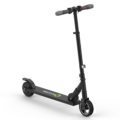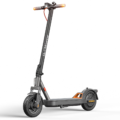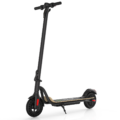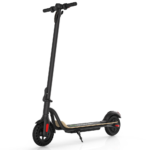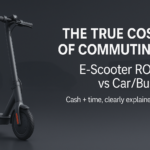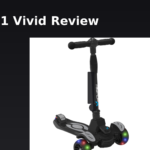- Home
- Scooters
- Electric Scooters
- MEGAWHEELS E2
MEGAWHEELS E2
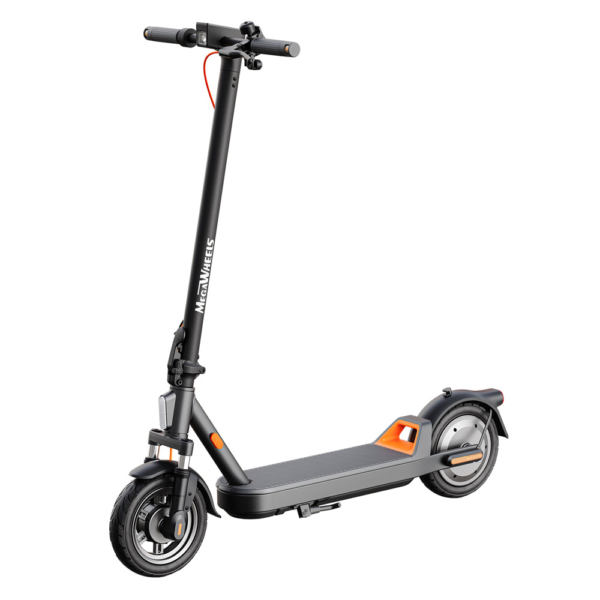

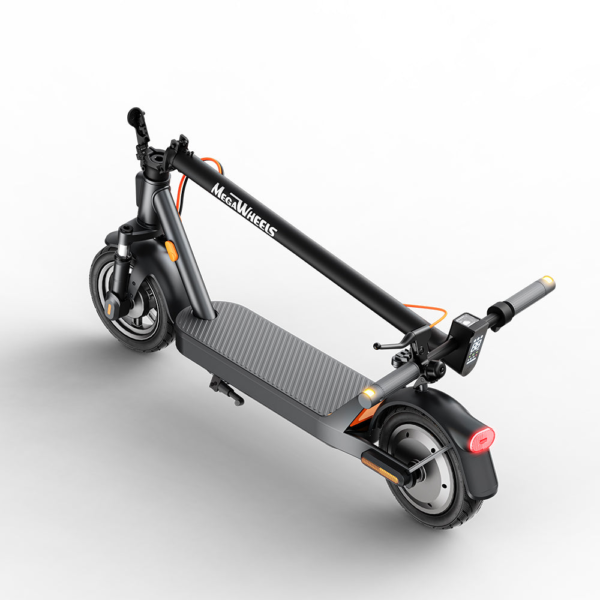
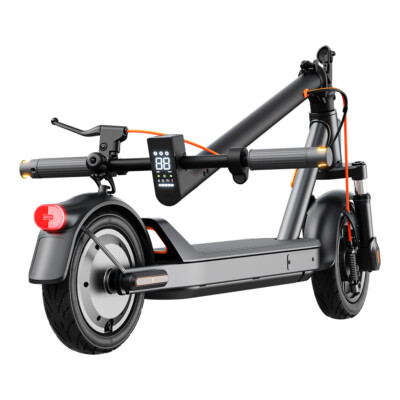
- Battery Range: 28 miles (45 km)
- Top Speed: 20 mph (32 km/h)
- Motor Power: 400 W
- Weight Capacity: 265 lb (120 kg)
- Charging Time: ~6 h
- Scooter Weight: 44.0 lb (20.0 kg)
PROS
- 20 mph cruising with 400W motor
- 28-mile claimed range
- 10″ pneumatic tires + front twin-tube suspension
- IPX5 rating
- High 265 lb load capacity
CONS
- Heavier at 44 lb
- Drum + electronic brakes (no disc)
- No rear suspension
- Compliance standard not stated
Table of contents
- What Is the MEGAWHEELS E2?
- How the MEGAWHEELS E2 Works
- Key Specifications
- Design & Build Quality
- Performance Fundamentals
- Battery, Range & Efficiency
- Ride Quality & Comfort
- Braking & Safety Features
- Portability & Daily Usability
- Maintenance & Care
- Weather & Seasonal Considerations
- MEGAWHEELS E2 vs Alternatives
- Who the MEGAWHEELS E2 Is (and Isn’t) For
- FAQs
- Glossary
- Final Thoughts
The MEGAWHEELS E2 is a city-friendly folding electric scooter designed for riders who want dependable range, practical comfort, and straightforward controls. With 10-inch pneumatic tires, a front twin-tube shock, and a drum + electronic braking system, it targets daily commuting and quick errands. If you value stable ride feel, easy maintenance, and a sensible balance of speed and efficiency, the MEGAWHEELS E2 fits the brief.
What Is the MEGAWHEELS E2?
The MEGAWHEELS E2 is a full-size, 36-volt folding e-scooter for adults and teens (12+ recommended). It pairs a 400 W hub motor (manufacturer-listed) with a 10.2 Ah battery and backs it up with 10×2.125-inch pneumatic tires for real damping from the road. The chassis uses aluminum, the cockpit is simple and legible, and the scooter adds useful touches like cruise control, app support, and a light system with headlight, tail light, and side “winglight” indicators.
You get a rated top speed of about 20 mph (32 km/h) and a stated range up to 28 miles (45 km) under set test conditions. Meanwhile, the platform supports riders up to 265 lb (120 kg), which gives the E2 a wide usability band for commuting, campus travel, and last-mile hops.
How the MEGAWHEELS E2 Works
At a glance, an e-scooter is a rolling system that converts battery energy into forward motion under electronic control. The E2 follows that model, yet adds a few rider-friendly layers.
Motor and controller. A brushless hub motor lives inside the rear wheel. The controller meters power to the motor based on your throttle input and selected speed mode. In practice, you’ll feel gentle take-off in the low mode, a balanced push in the medium mode, and the full tune in the high mode.
Battery and BMS. A 36 V lithium-ion battery sits inside the deck. Its rated capacity is 10.2 Ah with a rated energy ~360 Wh. An onboard Battery Management System guards against over-charge, over-discharge, over-current, and overheating. Because of that, the pack can deliver consistent power while protecting cell health.
Throttle and cruise. The right thumb throttle sends your request to the controller. Hold a steady throttle for several seconds and, if cruise is enabled, the scooter will maintain that speed until you tap the brake or adjust the throttle again. Cruise control is best on uncluttered paths; disable it when riding in busy settings.
Brakes and regen. The E2 uses a drum brake plus electronic braking. The drum provides mechanical stopping power you can modulate regardless of battery state. The electronic side adds motor-based deceleration and mild energy recovery. Together, they shorten stops and keep feel consistent across speeds.
Key Specifications
Below are the headline numbers organized by category. Conversions are shown to keep both metric and imperial readers on the same page.
| Block | Details |
|---|---|
| General | Model: MEGAWHEELS E2 • Frame: aluminum • App support: LEQISMART • Display: LCD • Speed modes: 3 (walk/standard/sport) • Recommended rider age: 12+ |
| Performance & Power | Motor: rear hub, listed 400 W (about 600 W peak per brand page) • Claimed climb: ~20% grade (~11.3°) • Top speed: 20 mph (32 km/h) |
| Battery, Charging & Electrical | Battery: 36 V, 10.2 Ah (rated energy about 360 Wh) • Charger: 42 V, 1.5 A (≈63 W) • Typical charge time: ~8 hours • BMS protections: over-heat/over-current/over-charge/over-discharge • Lights: front LED headlight, rear warning light, side winglight indicators • Waterproof rating: IPX5 |
| Build & Dimensions | Tires: 10 × 2.125 in pneumatics (254 × 54 mm) • Suspension: front twin-tube (≈35 mm) • Size (unfolded): 46.22 × 20.94 × 48.89 in (117.4 × 53.2 × 124.2 cm) • Size (folded): 46.22 × 20.94 × 21.26 in (117.4 × 53.2 × 54.0 cm) • Net weight: 44.35 lb (20.1 kg) • Max load: 265 lb (120 kg) |
| Safety & Control | Brakes: front/rear system with drum + electronic brake • Cruise control: available (toggle in app) • Photosensitive auto-lights behavior supported after reboot or app lock/unlock |
| Features & Extras | Cruise control • App lock/unlock • Unit toggle (mph↔km/h) • 3 speed modes • Kickstand • Tool set included |
| Warranty & Compliance | 12-month limited warranty for manufacturing defects (original owner) • IPX5 splash resistance • Operating temp: -10 °C to 40 °C (14–104 °F) • Storage temp: -20 °C to 50 °C (-4–122 °F) |
Note on power figures: the product page lists 400 W rated / ~600 W peak, while the user manual includes a maximum wheel-motor figure around 367 W. Real-world performance aligns more with the broader rated/peak window; either way, this class is tuned for city commuting rather than extreme acceleration.
Design & Build Quality
The E2’s frame uses aluminum for a practical mix of strength and weight. The stem is a single-tube design with a simple folding latch. It swings down to hook into the rear for a compact profile, although the folded height still reflects its large-wheel format. The deck is long enough for a natural stance, and the top surface gives your shoes ample grip.
Up top, the cockpit keeps controls clear. The LCD is easy to read in daylight and shows speed, battery bars, and mode. The throttle sits under the right thumb, and the brake lever is on the left. Two buttons control the side winglights, which function like directional indicators for awareness at intersections and path merges. Fit-and-finish lands where commuters need it: tidy cable routing, a solid bell-hook system for folding, and plastics that feel robust enough for repeated daily use.
Because the scooter rides on 10-inch pneumatic tires, the frame and deck can remain simple while the tires provide baseline damping. MEGAWHEELS adds a front twin-tube shock to further calm chatter. You still feel larger potholes, yet sidewalk seams and brickwork soften notably.
Performance Fundamentals
Acceleration. In Sport mode, the E2 pulls away with a confident yet controlled launch. It’s not a drag-race start, but the response is immediate and linear. Beginners can start in Standard mode to learn balance and throttle control. The Walk mode helps when sharing space with pedestrians.
Cruising stability. The 10-inch tire diameter matters. Larger wheels roll through cracks and shallow potholes with more stability than smaller commuter scooters. At neighborhood speeds, the chassis tracks straight, and the handlebar remains calm. As you approach the 20 mph (32 km/h) ceiling, you’ll still want two hands on the bar and your feet offset on the deck for a planted stance.
Hills. On rolling 7–10% grades, the E2 holds mid-teens mph in Sport for average-weight riders. On brief steeper ramps you’ll feel speed taper, yet the scooter continues climbing without fuss as long as you enter with momentum. If your route includes long, sustained ascents above 10% grades, plan a slightly slower pace to protect range and temperature headroom.
Battery, Range & Efficiency
The E2’s pack is 36 V, 10.2 Ah with a rated ~360 Wh energy content. Under steady 9 mph (15 km/h) in Standard mode, 165 lb (75 kg) rider, 25 °C (77 °F) ambient, flat pavement, and calm wind, the scooter’s typical range lands around 28 miles (45 km) per the brand’s stated conditions. Those variables aren’t random; they explain why your weekday range will vary.
What shifts real-world range?
- Speed: Holding 20 mph (32 km/h) draws more power than cruising at 12–15 mph (19–24 km/h).
- Rider weight & cargo: Heavier loads require more torque at a given speed.
- Terrain & stops: Hills and frequent stop-and-go add noticeable consumption.
- Temperature: Cold cells deliver less energy; heat can trigger protective limits.
- Tire pressure: Under-inflated tires increase rolling resistance and sap efficiency.
Charging. The charger is 42 V, 1.5 A (~63 W). A full charge typically takes around eight hours from low battery. Because lithium cells age by time and by elevated voltage, it’s smart to store the scooter between 40–60% if you won’t ride for several weeks. For daily use, you can charge to full, ride, and top up at work if needed. Avoid running to zero; stopping above one bar preserves both range and pack health.
Efficiency tips that actually help:
- Pump tires to the recommended pressure before each week.
- Use Standard mode for crowded routes; use Sport only when you’ll benefit.
- Keep cruising steady; throttle spikes burn watt-hours quickly.
- In winter, charge indoors at room temperature and depart with a warm battery.
Ride Quality & Comfort
Tire choice dictates ride character. The E2’s pneumatic 10×2.125-inch tires deliver the plushness many riders expect from a commuter scooter. Air volume absorbs buzz that solid tires would transmit to your hands. Because air tires can pinch-flat if you ride very under-inflated, routine pressure checks matter; however, the reward is a calmer, more controlled ride on cracked pavement.
The front twin-tube shock adds a second layer of comfort. It doesn’t transform the E2 into a long-travel machine, yet it noticeably trims sharp input from curbs and alley seams. Steering feel remains neutral. The stem shows minimal flex at legal urban speeds when you keep the hinge latched firmly and bolts snug. Ergonomically, the bar height suits a wide rider range (the manual’s guidance covers about 55–78 in rider height), while the deck encourages a natural, offset stance for stability.
Braking & Safety Features
Drum + electronic braking is a smart commuter solution. Drum brakes are sealed against weather and road grit, so they maintain bite in wet conditions and need little adjustment. The electronic component assists deceleration and may return a sip of energy to the pack. On the lever, you’ll feel progressive bite that builds after about half-pull, which helps prevent front-heavy lockups on slick surfaces.
The light system is comprehensive for an entry-level commuter: front LED to see and be seen, rear warning light for following traffic, and winglight indicators for side visibility when turning. The scooter’s IPX5 rating means it resists low-pressure water jets and typical road splash. That said, ride conservatively in rain, avoid deep puddles, and dry the scooter after wet commutes to preserve bearings and connectors.
Cruise control is available and useful on clear paths. However, you should disengage it before entering intersections, mixed-traffic areas, or unpredictable bike-share lanes. The photosensitive auto-light behavior re-arms after a reboot or an app lock/unlock cycle, which is handy if you commute at dusk.
Portability & Daily Usability
At 44.35 lb (20.1 kg), the E2 is light enough for short carries but still substantial. The folded profile is compact in height at 21.26 in (54.0 cm), so it fits under many desks and beside seats on trains. The latch is straightforward: lower the stem, hook it to the rear bell bracket, and you’ve got a manageable package. Commuters who climb multiple flights daily may prefer roll-to-elevator strategies over shoulder carries, but a one-floor stair lift is totally realistic.
Security remains part of usability. Use a sturdy U-lock or folding lock through the frame and a fixed rack; avoid locking only the wheel. Because e-scooter theft targets quick snatches, bring the scooter indoors when possible. For shared office or campus settings, the app lock adds an extra deterrent alongside your physical lock.
Maintenance & Care
The E2 is simple to keep in shape. Small, regular checks prevent big headaches later.
Every ride (30 seconds):
- Tires: Squeeze for firmness; top up weekly to the recommended PSI.
- Lights: Confirm headlight and tail light function.
- Latch: Verify the folding hinge clicks and holds.
Weekly:
- Inspect brake feel. If the lever travel lengthens, adjust per the manual.
- Wipe the deck and contact points; remove grit from around the drum.
Monthly (or 200–300 km):
- Check fasteners on the stem clamp, handlebar ends, and wheel hardware.
- Spin both wheels off the ground and listen for scraping that suggests rub or debris.
- Review the app for firmware updates and error prompts.
Seasonal:
- Before winter or a long storage period, clean, dry, and charge to about 50%.
- During storage, recharge every 3 months to protect the cells.
- Replace worn tires in matched pairs if tread or punctures become frequent.
Because the brake is a drum, you avoid pad swaps common on cable discs. The trade-off is slightly heavier wheel mass, though most commuters consider the near-zero maintenance worth it.
Weather & Seasonal Considerations
Rain. With IPX5 resistance, the E2 handles light rain and road spray. Still, slick paint lines and steel plates cut traction dramatically. Brake earlier, stay upright through turns, and keep speeds moderate. After wet rides, wipe the scooter dry, paying attention to the stem latch and brake mechanisms.
Heat. High temperatures can raise battery and controller temps. Park in shade when possible. If the scooter feels unusually warm after a climb, pause for a minute before charging or sprinting again. Heat management protects both electronics and tires.
Cold. Range drops in cold weather because chemistry slows. Keep the scooter indoors before you depart, ride with gentler acceleration, and accept a shorter distance per charge. Charging cold packs is hard on cells, so let the scooter warm to room temperature before plugging in.
MEGAWHEELS E2 vs Alternatives
Within commuter scooters, segments break down roughly into compact last-mile models, mid-range commuters with bigger wheels, and performance-oriented rigs with higher voltage and dual motors.
- Versus compact last-mile scooters: The E2’s 10-inch tires, front shock, and larger battery deliver visibly better comfort and range. It’s heavier, but the payoff is calmer handling on rougher pavement.
- Versus mid-range commuters with similar batteries: The E2 competes well on range and ride quality thanks to its pneumatic tires and IPX5 rating. Some rivals use cable disc brakes instead of drums. Discs can have a sharper initial bite, while drums keep maintenance low and work brilliantly in wet grit.
- Versus performance models: Torque monsters sprint faster and climb more aggressively with dual motors and 52 V+ systems. They also weigh much more, cost more, and can be overkill for crowded bike paths. The E2’s mission is reliable city transport and predictable manners, not off-road airtime.
If your daily loop mixes sidewalks, bike lanes, and occasional cobbles, the MEGAWHEELS E2 excels. If you routinely face 2–3-mile steep climbs or demand 25–30 mph cruising, a higher-voltage class is more appropriate.
For a baseline in the same lightweight-commuter class, compare it with the Segway Ninebot E2, which emphasizes approachable sizing and beginner-friendly control.
Who the MEGAWHEELS E2 Is (and Isn’t) For
Ideal for:
- Urban commuters seeking a stable, low-maintenance ride with practical range.
- Students who want a tough, everyday scooter that tolerates mixed surfaces.
- Multi-modal travelers who roll to trains or buses and value easy folding.
- New riders who prefer progressive braking, clear modes, and a forgiving chassis.
Less ideal for:
- Riders who require speeds beyond 20 mph (32 km/h).
- Hill-climbers living on sustained 10%+ ascents where higher voltage helps.
- Off-road explorers who want long-travel suspension and knobby tires.
FAQs
1) What is the real-world range of the MEGAWHEELS E2?
Under mixed urban use, plan for 15–25 miles (24–40 km) per charge depending on speed, rider weight, temperature, and hills. Riding slower and keeping tires properly inflated noticeably extends range.
2) How fast does it go?
The E2 is rated up to 20 mph (32 km/h) in Sport mode. Use Standard or Walk mode in crowded areas to manage speed more precisely.
3) Can I ride the E2 in the rain?
It carries an IPX5 rating, which means it resists low-pressure water jets and road splash. However, avoid deep standing water, brake earlier, and dry the scooter after wet rides.
4) Does the E2 have regenerative braking?
It uses electronic braking alongside a mechanical drum. The electronic system provides motor-based deceleration and mild energy recovery, while the drum supplies consistent stopping power in all conditions.
5) How long does charging take and what charger does it use?
A 42 V, 1.5 A charger (about 63 W) takes roughly eight hours to fill the 10.2 Ah pack from low.
6) What maintenance should I expect?
Keep tires at the correct pressure, verify lights and latch function, and check bolts monthly. Drum brakes require minimal adjustment compared with exposed disc setups.
7) Where can I find a quick MEGAWHEELS E2 overview?
You’re reading one. This guide covers the model’s purpose, battery and braking systems, sizing, and care.
Glossary
- Ah (amp-hours): Battery capacity measure. Higher Ah means more stored charge.
- Wh (watt-hours): Energy capacity (voltage × amp-hours). Indicates potential range.
- Controller: The electronic “brain” that meters battery power to the motor.
- Regen (regenerative braking): Uses the motor to slow the scooter and recapture a bit of energy.
- IP rating: Ingress Protection code; IPX5 means resistance to low-pressure water jets.
- Stem flex: The small elastic movement felt at the handlebar; too much can reduce confidence.
- PWM (pulse-width modulation): The way many controllers regulate motor power smoothly.
- Gradeability: The steepness a scooter can climb, usually expressed as a percent grade.
- BMS (Battery Management System): Protects cells from damaging conditions and balances charging.
- Pneumatic tire: An air-filled tire that cushions bumps and improves grip.
- Drum brake: A sealed brake inside the hub; reliable in wet and low-maintenance.
- Peak power: The short-burst maximum power output; higher than continuous “rated” power.
- Cruise control: Holds speed after a steady throttle input until you brake or adjust.
- Winglight indicators: Side lights that blink when you press the left/right buttons for turns.
- Standard mode: A middle power profile balancing speed and battery economy.
Final Thoughts
The MEGAWHEELS E2 focuses on what most commuters actually need: stable 10-inch wheels, a well-protected braking system, and a battery sized for real daily distances. Its cruise control and app add convenience, while front suspension and pneumatic tires keep the ride composed over cracked streets. It won’t outrun performance scooters, yet it consistently turns city miles into easy minutes.
If your priorities are calm handling, sensible range, and low maintenance, the MEGAWHEELS E2 lands right in the sweet spot.
Specifications
General
| Model The Model specifies the exact version or name of the scooter. It helps identify its unique design, features, and specifications within the manufacturer’s product line. Knowing the model makes it easier to compare options, find compatible accessories, or look up support information. | E2 |
| Brand The Brand identifies the manufacturer or company that designs and produces the scooter. A trusted brand is a sign of quality, reliability, and good customer support. Well-known brands often have higher standards for safety, performance, and after-sales service, giving you more confidence in your purchase. | MEGAWHEELS |
| Release Date The Release Date indicates when the scooter model was officially launched on the market. This helps you know how current the design, technology, and features are. A newer release date often means updated components, improved performance, and the latest safety or smart features. | 17 November 2025 |
| Recommended Age Recommended Age indicates the minimum age range that the scooter is designed for, based on safety, size, and ease of use. Following the recommended age helps ensure that riders can handle the scooter’s speed, weight, and controls comfortably and safely. Always check local laws and use protective gear, especially for younger riders. | +12 |
Performance & Power
| Motor Power (Wattage) What it means: The motor power, measured in watts (W), shows how strong the scooter’s electric motor is. Why it matters: Higher wattage usually means better acceleration, more torque, and improved performance on hills or rough terrain. For example, a 250W motor is good for flat city roads and light riders, while a 500W or 1000W motor provides more power for faster speeds or climbing steep inclines. | 400 W hub motor (600 W peak, stated) |
| Top Speed The Top Speed indicates the maximum speed that the scooter can reach under optimal conditions. It’s usually measured on level ground with a fully charged battery and an average rider weight. A higher top speed allows you to travel longer distances faster, but always ensure you ride within legal speed limits and your personal comfort zone for safety. | 20 mph (32 km/h) |
| Battery Capacity Battery Capacity refers to the total amount of energy the scooter’s battery can store, usually measured in ampere-hours (Ah) or watt-hours (Wh). A higher battery capacity means you can ride longer distances on a single charge, reducing the need for frequent recharging. Keep in mind that actual range can vary depending on rider weight, terrain, speed, and weather conditions. | 36 V 10.2 Ah (367 Wh) |
| Estimated Range per Charge The Estimated Range per Charge indicates the average distance the scooter can travel on a single full battery charge. This range is calculated under optimal conditions, such as flat terrain, moderate speed, and average rider weight. Real-world range may vary depending on riding style, terrain, weather, and load. A longer range means fewer recharges and greater freedom for longer trips. | 28 miles (45 km) |
| Hill Climb Ability Hill Climb Ability describes the maximum incline or slope that the scooter can handle while maintaining stable performance. It’s typically expressed as a percentage or in degrees. A higher hill climb rating means the scooter can tackle steeper hills without losing too much speed or power. Actual climbing performance may vary based on rider weight, battery charge, and terrain conditions. | 20% grade |
| Drive System The Drive System refers to how power from the motor is delivered to the wheels. Electric scooters typically use either a hub motor (directly integrated into the wheel) or a chain/belt drive system. A high-quality drive system ensures smooth acceleration, efficient power transfer, and low maintenance. The choice of drive system affects performance, noise level, and overall ride experience. | Not specified |
Charging & Electrical
| Charging Time Charging Time indicates how long it takes to fully recharge the scooter’s battery from empty to 100% using the standard charger provided. Faster charging means less downtime and more time on the road. Actual charging time may vary slightly depending on battery capacity, charger output, and environmental conditions. | Approx. 6 hours |
| Battery Type Battery Type refers to the specific technology used in the scooter’s battery, which affects performance, lifespan, weight, and charging time. Most modern electric scooters use high-quality lithium-ion (Li-ion) batteries because they offer a good balance of energy density, durability, and low maintenance. A reliable battery type ensures consistent power delivery and longer riding ranges. | Lithium-ion pack (BMS not specified) |
| Removable Battery A Removable Battery means the battery pack can be easily detached from the scooter for convenient charging and replacement. This feature allows you to charge the battery separately, swap it with a spare for extended range, or securely store it indoors in extreme weather. Removable batteries add flexibility and make it easier to keep your scooter powered up wherever you are. | Non-removable internal battery (fixed pack) |
| Regenerative Braking Regenerative Braking is an energy-saving feature that converts some of the energy normally lost during braking back into battery power. When you slow down or brake, the motor works in reverse to generate electricity, which helps extend the scooter’s range and improves overall efficiency. This system also reduces wear on traditional brake components, leading to lower maintenance over time. | Not specified |
| Lighting Lighting refers to the built-in front and rear lights that enhance visibility and safety when riding in low-light conditions or at night. Good lighting helps you see the road ahead and ensures that other road users can see you. Many scooters include LED headlights, taillights, and sometimes brake lights or side reflectors for added safety and compliance with local traffic regulations. | LED headlight + rear warning light |
Build & Dimensions
| Scooter Weight Scooter Weight refers to the total weight of the scooter when fully assembled, including the battery. This affects how easy it is to carry, lift, and store the scooter when not in use. A lighter scooter is more portable and convenient for commuting, especially if you need to carry it upstairs or onto public transport. Keep in mind that a sturdy frame and quality components may add to the weight but also contribute to better durability and ride stability. | 44.0 lb (20.0 kg) |
| Maximum Rider Weight Maximum Rider Weight indicates the highest rider weight that the scooter is designed to safely support while maintaining optimal performance and stability. Staying within this limit helps ensure reliable acceleration, braking, and climbing ability, and it protects the frame, suspension, and motor from excessive strain. Exceeding the recommended limit may reduce performance and increase wear on components. | 265 lb (120 kg) |
| Deck Size Deck Size refers to the dimensions of the scooter’s standing platform. A wider and longer deck provides more foot space, allowing you to stand comfortably and adjust your stance while riding. A well-sized deck improves balance and stability, especially on longer rides or at higher speeds. Compact decks, on the other hand, help keep the scooter lightweight and portable. | Commuter geometry; low deck; front twin-tube shock |
| Handlebar Height Handlebar Height refers to the distance from the deck to the handlebars, which affects your riding posture and comfort. An appropriate handlebar height helps you maintain good balance, reduces strain on your back and arms, and makes steering more comfortable. Some scooters have adjustable handlebars to fit riders of different heights, while others have a fixed height for a streamlined design. | Not specified |
| Folding Mechanism The Folding Mechanism describes how easily and securely the scooter can be folded for carrying and storage. A well-designed folding system lets you quickly collapse the scooter into a compact size, making it convenient to transport on public transit, store under a desk, or fit into a car trunk. Look for sturdy latches and safety locks to ensure the scooter stays firmly in place when folded or unfolded. | Foldable (mechanism not specified) |
| Dimensions Folded Dimensions indicate the size of the scooter when it’s fully folded. This measurement shows how much space the scooter will take up when stored or carried, making it easier to check if it will fit in your car trunk, under a desk, or in a closet. Compact folded dimensions are ideal for commuters who need to bring their scooter on public transport or store it in tight spaces. | Unfolded: 46.2 × 20.9 × 48.9 in; Folded: 46.2 × 20.9 × 21.3 in |
| Material Material refers to the primary construction materials used for the scooter’s frame and key components. High-quality materials like aircraft-grade aluminum, reinforced steel, or durable composites provide strength, stability, and a lighter overall weight. A sturdy material ensures the scooter can handle daily wear and tear while maintaining safety and performance. | Aluminum alloy |
Safety & Control
| Brake Type(s) Brake Type(s) describe the braking systems the scooter uses to help you slow down or stop safely. Common brake types include mechanical brakes (like drum or disc brakes), electronic brakes, and foot brakes. Many scooters combine multiple braking systems for added safety and shorter stopping distances. The type and quality of brakes affect your control, especially when riding at higher speeds or on slopes. | Front electronic + rear drum |
| Suspension Suspension refers to the system that absorbs shocks and vibrations while riding, providing a smoother and more comfortable ride over uneven or rough surfaces. Scooters may have front suspension, rear suspension, or dual suspension for better shock absorption and stability. Good suspension helps reduce rider fatigue and improves control, especially when riding on bumpy roads or off-road paths. | Front |
| Tire Type Tire Type refers to the kind of tires the scooter uses, which directly affects ride comfort, traction, and maintenance. Common types include solid (airless) tires, pneumatic (air-filled) tires, or hybrid options. Pneumatic tires offer better shock absorption and a smoother ride on rough surfaces, while solid tires are puncture-proof and require less upkeep. The right tire type helps ensure safe handling and a comfortable ride in different conditions. | 10″ pneumatic |
| Tire Size Tire Size indicates the diameter and width of the scooter’s tires, which affect ride comfort, stability, and how well the scooter handles different terrains. Larger tires generally offer better shock absorption and a smoother ride over bumps and rough surfaces, while smaller tires keep the scooter lighter and more portable. Choosing the right tire size helps ensure a balance between agility and comfort. | 10-inch |
| Kickstand The Kickstand is a built-in stand that allows you to park your scooter upright when it’s not in use. A sturdy kickstand keeps the scooter stable and prevents it from tipping over, protecting it from scratches and damage. It also makes storing and accessing your scooter more convenient, whether you’re at home, work, or on the go. | Side kickstand |
| Water Resistance Rating Water Resistance Rating indicates how well the scooter is protected against water and moisture, usually shown as an IP (Ingress Protection) rating. This rating helps you understand whether the scooter can handle light rain, splashes, or wet roads without damage. While most scooters are not fully waterproof, a good water resistance rating adds peace of mind when riding in changing weather conditions. Always avoid deep puddles or submerging the scooter to protect its electrical components. | IPX5 |
Features & Extras
| Display/Console The Display (or Console) shows important real-time information about your ride, helping you monitor your scooter’s status at a glance. Typical displays show speed, battery level, distance traveled, and riding mode. Some models also include additional features like Bluetooth connectivity, app integration, or backlighting for better visibility at night. A clear and easy-to-read display enhances safety and convenience on every trip. | LCD display (speed/battery) |
| Ride Modes Ride Modes refer to the different speed and power settings you can choose to match your riding style or road conditions. Common modes include eco for maximum range and energy efficiency, standard for everyday balance, and sport or turbo for higher speed and stronger acceleration. Switching between ride modes allows you to customize performance, conserve battery, and ride safely in various environments. | 3 speed modes |
| Smart App Connectivity Smart App Connectivity lets you pair your scooter with a dedicated mobile app via Bluetooth. Using the app, you can monitor real-time ride stats like speed, battery level, and range, adjust settings such as ride modes or cruise control, lock the scooter for added security, and sometimes receive firmware updates. This feature adds convenience and allows you to personalize your riding experience right from your smartphone. | Bluetooth app (brand app) |
| Anti-Theft System The Anti-Theft System helps protect your scooter from unauthorized use or theft. This feature can include built-in alarms, electronic motor locks, GPS tracking, or remote locking through a mobile app. A good anti-theft system provides peace of mind when parking your scooter in public spaces, adding an extra layer of security to safeguard your investment. | Not specified |
| Cruise Control Cruise Control allows you to maintain a steady speed without continuously holding the throttle. This feature makes longer rides more comfortable by reducing hand fatigue and providing a smoother, more relaxed riding experience — especially on flat, open roads or bike lanes. For safety, cruise control can usually be easily activated or deactivated while riding. | Not specified |
| Accessories Included Accessories Included lists the additional items that come with the scooter to enhance your riding experience and convenience. Common accessories may include a charger, kickstand, bell, lights, phone holder, or carrying strap. These extras add value by making your scooter safer, easier to use, and ready to ride straight out of the box. | Scooter, charger, user manual, tool set |
Warranty & Compliance
| Warranty Period The Warranty Period indicates how long the manufacturer guarantees the scooter against defects in materials and workmanship under normal use. A good warranty provides peace of mind, showing the brand’s confidence in its product quality. Always check what parts are covered, such as the frame, battery, and motor, and follow the maintenance guidelines to keep your warranty valid. | 12 months (region-dependent) |
| Certifications Certifications confirm that the scooter meets specific safety, quality, and environmental standards set by recognized organizations or regulatory bodies. Common certifications may include CE, RoHS, UL, or other local compliance marks, depending on your region. These certifications ensure that the scooter is manufactured to high standards and is safe and legal to use in your country. | Region-dependent |


